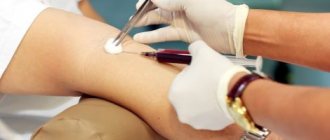Thrombocytapheresis
Almost any healthy person over 18 years of age can become a donor. However, there are certain medical and social contraindications to donating blood and its components. Various diseases, operations suffered in the recent past, trips to certain parts of the world - all this can serve as a temporary or permanent excuse from donation. You will find a detailed list of contraindications below.
In addition, you should know that the donor must weigh at least 50 kg. Body temperature measured before blood donation should be no higher than 37°C; permissible systolic pressure - from 90 to 160 mmHg, diastolic - from 60 to 100 mmHg; permissible pulse rate is 50-100 beats per minute.
If you have diseases that are not included in the above list, or you are taking any medications, tell the doctor at the station or blood transfusion department, and he will decide whether you can be a donor or not. An examination by a doctor and a conversation between a doctor and a donor are mandatory procedures before donating blood or its components. Do not hide your ailments from the doctor, answer his questions and the questionnaire honestly, and then donation will be safe both for you and for those for whom you are donating blood or its components.
In Moscow and the Moscow region, some medical institutions require donors to register in Moscow or Moscow region - permanent or temporary (at least 6 months). However, other blood transfusion departments also accept blood from regionally registered donors. To find out what a specific facility's registration requirements are, contact our Donor Coordinator or find that facility on the list and read the description of the blood donation requirements.
If you are donating blood not in Moscow, but in another region of Russia, call the station or blood transfusion department in advance to find out what requirements they have for donor registration.
Thank you for being ready to become a donor or have already become one!
- Donor Safety Basics
- How are blood and its components donated?
Benefits of donation
Medical experts believe that regular donation of blood provides a person with the prevention of diseases of the immune system.
In this case, we are talking about cumulative diseases caused by metabolic disorders, which include gout, atherosclerosis, as well as dysfunction of the pancreas, stomach and liver. Researchers have also proven that systematically donating blood for transfusion to patients can reduce the likelihood of cardiovascular pathologies, since excess blood and its components gradually put more strain on the blood vessels and heart. It sounds strange, but donation can be a good prevention of sudden bleeding. The body, accustomed to actively producing new blood, will be able to restore strength faster. After all, one of the reasons for women’s longer life expectancy is systematic blood loss in the form of menstruation.
It is worth taking into account that the donor in most cases experiences a colossal surge of positive emotions. In addition, another significant bonus is that diagnostics of the body before donating blood are carried out absolutely free.
The benefits of bloodletting for the male and female body
The answer to the question whether it is useful to donate blood to men, the answer will always be positive, provided there are no contraindications.
For members of the male population, donating blood and plasma components after the age of 40 brings significantly more benefits than for young men.
With the female body the situation is a little different.
Often representatives of the fairer sex have a question about whether it is useful to donate blood to women. The answer to this question largely depends on the woman’s age.
During the childbearing period, during menstruation, the female body loses a noticeable part of the blood, which leads to its renewal, so women at this age have less need for bloodletting.
If a lady decides to become a donor, then the breaks between procedures for donating biomaterial should be significant so that the body has time to recover.
This situation does not apply to women at the age of menopause. During this period, bloodletting brings more benefits to them than to young people due to the absence of menstruation.
All of the above factors indicate that in order to get an accurate answer about the benefits of donation for women, you should know exactly the age of the potential donor.
Who is allowed to be a donor
A healthy person, regardless of gender, between 18 and 60 years of age can become a donor. The donor's weight must be fifty kilograms or more, and the donor's constant body temperature must be up to 37 degrees Celsius. Acceptable values for systolic pressure range from 90-160 units, and diastolic pressure – 60-100 units. Pulse rate – 50-100 beats per minute.
People are allowed to donate blood strictly after consultation with a therapist and transfusiologist, as well as an examination of the body.
What is the Rh factor of blood?
The Rh factor is a blood characteristic that has long been beyond human understanding. Even after blood groups were discovered, the Rh factor remained unknown. It is an antigen protein found on the surface of red blood cells.
The Rh factor can cause agglutination (sticking and precipitation) of red blood cells during blood transfusion, so it is important that the blood matches not only the group, but also the Rh factor. If there is an antigen protein on the surface of red blood cells, a person will have a positive Rh factor, approximately 85% of such people. If it is absent, it is negative. There are much fewer people with negative Rh factor - 15%.
A dangerous situation arises when there is a conflict of Rh factor in pregnant women, when the Rhesus of the mother and fetus do not match. Antibodies produced by the body of the expectant mother cause the breakdown of the fetal red blood cells. This is fraught with hemolytic jaundice of newborns.
Absolute contraindications
AIDS, HIV, syphilis, viral hepatitis, tuberculosis, brucellosis, typhus, leprosy, echinococcosis, oncology, diseases of the circulatory, nervous and cardiovascular systems, emphysema, bronchial asthma, obstructive bronchitis, chronic liver diseases, calculous cholecystitis, cirrhosis of the liver , stomach and duodenal ulcers, urolithiasis, diffuse and focal kidney damage, pathologies of the endocrine system with severe functional and metabolic disorders, high myopia (from 6 D), complete blindness, acute and chronic severe purulent-inflammatory diseases of the ENT- organs, psoriasis, erythroderma, eczema, pyoderma, sycosis, lupus erythematosus, blistering dermatoses, fungal infections of internal organs and skin, acute and chronic osteomyelitis, pustular skin diseases, surgical interventions in case of organ resection or, conversely, transplantation (replacement of affected organs and tissues).
Interesting facts about blood donation
- The first documented blood transfusion took place on June 15, 1667. French doctor Jean-Baptiste Denis transfused 300 ml of sheep blood into a 15-year-old boy. The boy survived the operation.
- The world's most famous donor donated blood 624 times, totaling about 500 liters.
- The word “donor” itself comes from the Latin “donare”, which means to give. This emphasizes voluntary and selfless blood giving, although in some cases there is a monetary reward for it
- According to the World Health Organization, donors live 5 years longer on average. This is due to the constant stimulation of the immune system, which occurs with small, regular crop losses.
- It is believed that every third inhabitant of the Earth at least once in his life is faced with the need for a transfusion.
- For the normal functioning of the healthcare system, it is necessary that there are 40 donors for every 1000 inhabitants. In Europe this figure is 25-27 people, in Canada or the USA – 35-40, in Russia – about 14.
Temporary contraindications
Transfusions of blood or its components, surgical interventions, including abortion, tattooing or acupuncture of the donor, stay on business trips for more than 2 months in a row, stay in malaria-endemic countries in subtropical and tropical climates for more than 3 months, a history of malaria in the absence symptoms and negative results of immunological tests, close contact with patients with hepatitis, typhoid fever after recent recovery, influenza, ARVI, tonsillitis, tooth extraction, vegetative-vascular dystonia, acute or chronic inflammatory processes in a state of exacerbation, menstruation, pregnancy and lactation, allergies in the state exacerbations, recent vaccinations, taking medications or products containing alcohol. For each of these and other possible reasons, people are temporarily prevented from donating. More detailed information can be found by making an appointment with a hematologist.
Why is donating blood useful? Interview with a doctor
Today, April 20, is celebrated in Russia as National Blood Donor Day. Every day, volunteers go to blood transfusion centers and give a part of themselves to other people, most often young people and students. Contrary to the prevailing opinion that you can make money from this, donation is done free of charge. As Elena Semyonova, head of the organizational and methodological department of the Omsk Region Blood Center, says, they come at the call of the heart. She told Omsk Here about people who donate blood, their motives, the existing risks and why donors are always needed.
The Blood Center is located in the heart of Neftyaniki at st. Magistralnaya, 35. On average, 100 people donate blood every day. This is enough to provide local medical institutions with components of donor blood in full.
— In general, there are enough blood donors. We try to regulate their number. In any case, we fully satisfy the needs of medical institutions throughout the year. But I would like the population to be informed about donation, so that people know where to go. We are interested in primary donors, since regular donors (those who donate regularly) leave over time. Some due to health reasons, others receive the title “Honorary Donor” and stop donating, others leave the region. There is an outflow. We are interested in people coming not just once, but coming again,
- Elena Semyonova emphasized.
Elena Semyonova (photo from the doctor’s personal archive)
Since there are many people with blood group I, its reserves practically do not dry out. However, group IV blood is often needed, especially with a negative Rh factor. The fact is that there are significantly fewer people with such blood than others.
— The need is determined by those patients who are in medical institutions in the Omsk region. If there are few supplies left, then we invite donors with this blood type. It all depends on the need. When people urgently need blood, it is taken from the bank and then simply replenished. Every day our center provides blood components to medical institutions not only in the city, but also in the region. Naturally, we need to replenish supplies every day,
— the interlocutor clarified.
In modern medicine, single-group blood is transfused to the recipient, as the range of indicators for which the blood should be suitable for the patient has expanded.
“Medicine has nevertheless moved forward, and, in addition to group and rhesus, there are also indicators that must be combined. Some people have Kell factor (one of the proteins) in their blood. For example, a person comes to a blood donation and does not know that he is present. Such donors can only donate plasma and serum. Because most people don't have the Kell factor. If you transfuse the blood of a person with Kell factor into a recipient who does not have it, there may be complications. But this is not a disease, it is the same as with the Rh factor. Blood is a whole microcosm,
- said the speaker.
When it comes to blood transfusions, images from films often appear before our eyes: tubes are attached to the veins of two people and blood flows through them from one to the other. However, this is a misconception.
— Now “fresh” blood does not immediately flow to the recipient. Direct transfusion is not used. When we collect blood, it is examined another day after collection. Laboratory tests are carried out, including biochemical tests, for infections. In addition to the Blood Center, there are also departments at medical institutions in the region. They try to provide themselves with the necessary amount of donor blood. Then the plasma received from donors is quarantined for six months. This period is necessary because this is the incubation period for hepatitis. After this period, it is necessary to re-test the donor blood. If the donor is healthy, then the prepared components are given to medical institutions,
- the doctor explained.
To become a donor, you first need to take care of your health. There should be no contraindications. According to the specialist, they can be permanent or temporary. The first include viral hepatitis, tuberculosis and a number of other diseases - these are absolute contraindications. Temporary are acute respiratory infections and acute respiratory viral infections, influenza and others. Also, women who have given birth can become donors only one year after the birth of the child. If they are still breastfeeding after this period, then only three months after breastfeeding has ended. Also, temporary contraindications include operations, since during surgery there is blood loss and the body needs to recover as a whole. If there are no obvious contraindications, then a Russian citizen with a passport can come to the Center and fill out a form and undergo a medical examination.
— The donor fills out a questionnaire, answering a series of questions. The individual is responsible for the accuracy of the data. Concealing information may result in penalties including criminal penalties. Then, during the conversation, the doctor looks at all the documents, the results of a rapid blood test, measures height, weight and then decides whether to admit it or not. After this, the donor goes to the buffet, drinks tea, and then donates blood,
— Elena Vladimirovna spoke in more detail about the preparation.
Doctors recommend that donors weigh at least 58 kg. On the eve of donating blood, you should not drink alcohol, take medications, or eat fatty or spicy foods. Dairy products are also prohibited. In the morning of the day of delivery, you need to drink sweet tea with white bread.
Please note that only adults can become donors. But the top frame is not limited. If health permits, people over 60 years of age can donate blood. As Elena Semyonova explained to us, a fairly large amount of blood is taken from a person, and it is impossible to donate it more often than once every two months.
— We take 450 ml of blood, plus another 40 ml for tests, and the result is a large blood loss. And the organs that produce blood cells become active and more intensively replenish the blood that the donor has lost. It takes 60 days to recover. You cannot return to take the test again earlier than two months later. The organ that produces blood is constantly in an active phase; if the regime is not followed, diseases may occur. First of all, high blood pressure. Therefore, the interval is very important to observe. According to regulatory documents, men can donate blood five times during the year, and women four times.
— the interlocutor clarified.
However, plasma can be donated every two weeks.
If you follow all the doctors’ recommendations, then there are mainly advantages for donors. One of the positive aspects is the body's ability to tolerate blood loss.
— In an emergency situation, the donor will more easily tolerate blood loss because the body is already trained. The body will simply turn on its defense mechanisms, and the patient will come out of this state more easily. It is more likely that he will survive this situation. Another plus is that the blood is rejuvenated,
- the doctor emphasized.
Donation is developing, and this area of medicine, like any other, needs support. Since 2008, Russia has been implementing a state program for the development of voluntary donation. At that time, the task was to increase the number of primary donors. Over the past two years, doctors have been striving to maintain the number of personnel donors.
—
When this program was adopted, equipment was updated in the Blood Service throughout the country. Participation in the Federal Program for the Development of Blood Services allowed the institution to work in new conditions and meet modern requirements for the quality of donor blood components. We also have new opportunities for examining donor blood and processing it. We prepare plasma, erythrocyte-containing components, and blood cells in accordance with requests from medical institutions, ” Elena Vladimirovna emphasized.
As for specialists in this field, according to Semyonova, there are not as many of them as we would like, but there is no shortage of personnel.
— They can’t come to us right after university, because there is a system of professional retraining. This may take several years. Most people come to us with work experience,
- the doctor noted.
In the Omsk region, social support for donors has been available since 2007. Now Omsk residents are paid 500 rubles for one blood donation. In addition, after donating blood, donors receive a small food package and certificates for two days of rest.
— BUZOO “Blood Center” fulfills the task of meeting the needs of medical institutions for components of donor blood.
To date, the number of personnel donors has been increased and maintained ,
” Elena Semyonova summed up.
Photo: Ekaterina Kharlamova
Harm of donation
Donation is undoubtedly a necessary and noble cause. But any intervention in the human body (especially at this level) is far from being as simple as it seems to many. Be that as it may, each type of donation (blood, skin, internal organs, etc.) poses certain risks for both the donor and the recipient (recipient).
Risk for the recipient. Many people, as well as their relatives, worry that when taking blood they may be infected with some kind of disease. In fact, the recipient of the blood is more likely to become infected. After all, to draw blood, you should only use disposable instruments and consumables. But the recipient receives someone's blood. For example, during a difficult birth, you cannot use donor blood from a person who drank alcohol or smoked cigarettes less than 2 days before donating it. Otherwise, the newborn runs the risk of poisoning the body. People with weakened immune systems are at greatest risk of contracting something from a blood transfusion.
Risk for the donor. It should be noted once again that if the rules for donating blood are followed, the negative consequences for the health of the donor are minimal.
Summarizing all that has been said, it is clear that the benefits of blood donation are obvious, and the risks of contracting infectious and other diseases are reduced to zero.
Other points of delivery
It is dangerous to be a donor if the rules are not followed. You need to donate blood at special collection points equipped with the necessary equipment and qualified personnel. You cannot give consent to blood sampling without preliminary tests and examination by a doctor.
Donating blood is a free procedure. To recuperate, a person is given a paid day off. The blood collection process lasts about 30 minutes.
Sometimes, a transfusion from a donor involves taking not blood, but some part of it. For example, red blood cells, white blood cells or plasma. In this case, the donor's blood passes through a centrifuge, where the components necessary for transfusion are selected, and the remaining parts of the blood are returned to the donor vessel.










